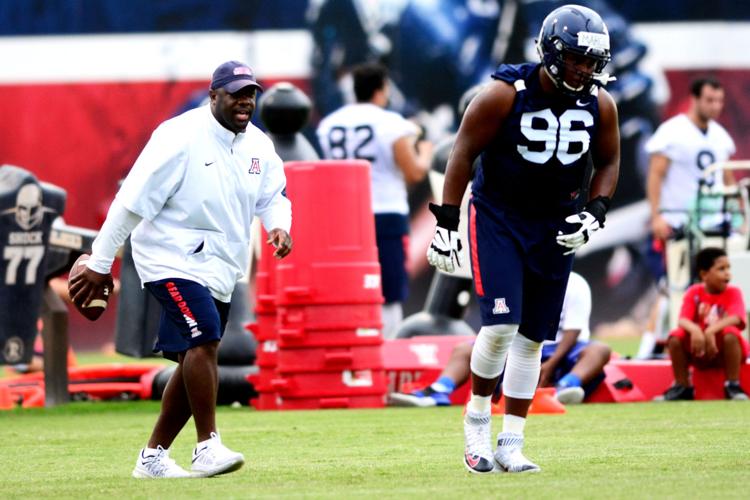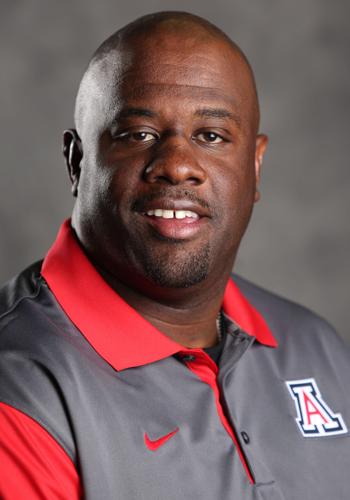Arizona Wildcats defensive coordinator Marcel Yates moved from the coaches’ box to the sideline three games ago. Those three games represent the most consistent stretch his defense has played since he came to Tucson last year.
Coincidence? Maybe. Or maybe not.
Many factors have contributed to Arizona’s recent defensive turnaround, including experience in Yates’ system and an infusion of young talent. But Yates’ presence on the sideline surely is one of them.
Yates spent last season, his first at Arizona, in the booth. Several coaches watch the game from above, where they can see all 22 players, and communicate via headsets with personnel on the sideline.
Yates has positioned himself in both spots at previous stops. He decided it made more sense to be on the field with this particular Wildcats defense, which features several freshmen playing prominent roles. So after Week 1 against Northern Arizona – the UA’s worst defensive performance of 2017 – Yates switched positions with linebackers coach Scott Boone.
“You’re more into it,” Yates said Wednesday after Arizona’s second bye-week practice. “Being up in the box is more like a video game. Being on the field … there’s more emotion. You feel more connected to the game and to the players.”
On the sideline, Yates is able to address the entire defense without having to wait until halftime. He can get a better feel for the players’ emotional state, and he can make quicker adjustments.
“Since he’s been down there, when we see something that happens, we change it instantly,” freshman defensive tackle Kurtis Brown said. “That’s been a big key for us.”
Take last week’s game against Utah. Arizona allowed a touchdown on the opening drive. The Utes needed just six plays to go 73 yards.
Yates felt the defense was playing too soft and let the unit know about it. The Wildcats allowed only one offensive touchdown the rest of the game.
“I thought we were lackadaisical. … They were taking it to us,” Yates said. “So I was able to get on them a little bit and get them going.”
For the most part, the generally laid-back Yates helps reassure Arizona’s young, excitable defense — providing ice to UA coach Rich Rodriguez’s sideline fire. Yates’ presence on the field might not matter as much for a veteran group. Arizona starts three true freshmen and one redshirt freshman on defense. Another true freshman, linebacker Colin Schooler, plays regularly.
“We’ve got so many young guys, I think it helps having the coordinator down on the field to calm them down a little bit and communicate some,” Rodriguez said.
“Every experience they get in the games now is like the first time for them. As they get older, they’ll kind of been there, done that; the things that happen in the game won’t be fresh and new.
“Not that they’re panicking, but it’s all a new experience. Especially now in the first half of the year, having a coach down there (to) settle them a little bit, calm them down, tell them what’s happening, it’s going to be very beneficial.”
It’s impossible to draw a direct correlation between Yates’ being on the sideline and the defense playing better. But the numbers certainly suggest it’s working so far.
Arizona allowed 562 yards against NAU; it has surrendered an average of 314 since. The Lumberjacks converted 10 of 19 third downs against the Wildcats; the past three opponents have converted 10 of 37.
In other words, don’t expect Yates to return to the coaches’ box anytime soon.
“I’ve done them both,” Yates said. “I feel comfortable doing both. I think with this team, it’s better for me to be on the field.”
If you build it …
The Arizona Board of Regents is meeting this week in Flagstaff, where the agenda items include a proposal for a new indoor sports center. The facility is part of the UA’s Capital Improvement Plan for fiscal years 2019-21 and also includes upgrades to Arizona Stadium.
The indoor sports center would provide the football team and other squads a place to train during Tucson’s sweltering summer and monsoon season. The estimated cost is $18 million. If approved, construction would begin in April 2018 and conclude by November.
Rodriguez has been pushing for an indoor facility for several years.
“Everybody’s been supportive on campus,” he said. “They know what we need facility-wise.
“We’re fortunate that we have the land space right here where our football facility is to do some things. Hopefully, in the near future, we’ll get some stuff done.”
Rodriguez believes the new building would be a boon for recruiting. He experienced that first-hand with the construction of the Lowell-Stevens Football Facility, which sits at the north end of Arizona Stadium and houses the football team’s locker room, coaches’ offices, meeting rooms and weight room. Rodriguez took over the UA program in November 2011. LSFF opened in July 2013.
“We were able to sell that when I first got here,” Rodriguez said. “Even though it wasn’t built yet, it was getting built. And then we were able to sell it after it was built: ‘See, we told you. We’re committed to football.’ ”
Extra points
- Rodriguez said he’s “not too optimistic” about sophomore safety Isaiah Hayes being able to play this season. Hayes, who became a starter as a freshman last year, has been out since August because of a shoulder injury. “I’m not sure how long it’ll be,” Rodriguez said, “but right now it doesn’t look like he’ll be playing anytime soon.”
- With Hayes out, freshman Scottie Young Jr. has performed well at free safety, drawing praise from coaches and teammates since the start of training camp. “He’s jumped into the starting role like he’s been here for years,” Rodriguez said.
- Rodriguez on now-healthy sophomore quarterback Khalil Tate: “He’s got to keep getting reps. He’s still learning. He’s such a young guy — 18 years old. But he’ll be OK.”
- Brown said injured senior Parker Zellers (ankle) has helped him immensely while being sidelined. Brown hasn’t started but basically has taken Zellers’ spot in the rotation. Zellers probably will return for the Colorado game next week.





